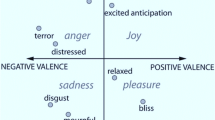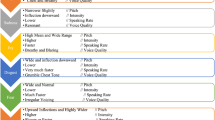Abstract
This paper focuses on a novel approach of distress detection referred to as the 2D approach, using the fuzzy K-NN classification model. Unlike the traditional approach where single emotions were qualified to depict distress such as fear, anxiety, or anger, the 2D approach introduces two phases of classification, with the first one checking the speech excitement level, otherwise referred to as arousal in previous researches, and the second one checking the speech’s polarity (negative or positive). Speech features are obtained from the Berlin Database of Emotional Studies (BDES), and feature selection done using the forward selection (FS) method. Attaining a distress detection accuracy of 86.64% using fuzzy K-NN, the proposed 2D approach shows promise in enhancing the detection of emotional states having at least two emotions that could qualify the emotion in question based on their original descriptions just as distress can be either one or many of a number of emotions. Application areas for distress detection include health and security for hostage scenario detection and faster medical response respectively.
Access this chapter
Tax calculation will be finalised at checkout
Purchases are for personal use only
Similar content being viewed by others
References
Norris, C., McCahill, M., Wood, D.: The growth of CCTV: a global perspective on the international diffusion of video surveillance in publicly accessible space. Surveill. Soc. 2(2/3) (2002)
Knapp, R.B., Kim, J., André, E.: Physiological signals and their use in augmenting emotion recognition for human–machine interaction. In: Cowie, R., Pelachaud, C., Petta, P. (eds.) Emotion-Oriented Systems, pp. 133–159. Springer, Heidelberg (2011). https://doi.org/10.1007/978-3-642-15184-2_9
Pfister, T.: Emotion detection from speech. Gonville and Caius College (2010)
Ekman, P.: An argument for basic emotions. Cognit. Emot. 6(3–4), 169–200 (1992)
Ang, J., Dhillon, R., Krupski, A., Shriberg, E., Stolcke, A.: Prosody-based automatic detection of annoyance and frustration in human-computer dialog. In: INTERSPEECH, Citeseer (2002)
Watson, D., Pennebaker, J.W.: Health complaints, stress, and distress: exploring the central role of negative affectivity. Psychol. Rev. 96(2), 234 (1989)
Pearson, E.: Torts-emotional distress (1971)
Nicholson, J., Takahashi, K., Nakatsu, R.: Emotion recognition in speech using neural networks. Neural Comput. Appl. 9(4), 290–296 (2000)
Trentin, E., Scherer, S., Schwenker, F.: Emotion recognition from speech signals via a probabilistic echo-state network. Pattern Recogn. Lett. 66, 4–12 (2015)
Keller, J.M., Gray, M.R., Givens, J.A.: A fuzzy k-nearest neighbor algorithm. IEEE Trans. Syst. Man Cybern. 4, 580–585 (1985)
Lefter, I., Rothkrantz, L.J., Van Leeuwen, D.A., Wiggers, P.: Automatic stress detection in emergency (telephone) calls. Int. J. Intell. Def. Support Syst. 4(2), 148–168 (2011)
Johnstone, T., Scherer, K.R.: The effects of emotions on voice quality. In: Proceedings of the XIVth International Congress of Phonetic Sciences, University of California, Berkeley San Francisco, pp. 2029–2032 (1999)
Hansen, J.H.L., Patil, S.: Speech under stress: analysis, modeling and recognition. In: Müller, C. (ed.) Speaker Classification I. LNCS (LNAI), vol. 4343, pp. 108–137. Springer, Heidelberg (2007). https://doi.org/10.1007/978-3-540-74200-5_6
Kollmeier, B., Brand, T., Meyer, B.: Perception of speech and sound. In: Benesty, J., Sondhi, M.M., Huang, Y.A. (eds.) Springer Handbook of Speech Processing, pp. 61–82. Springer, Heidelberg (2008). https://doi.org/10.1007/978-3-540-49127-9_4
Clavel, C., Vasilescu, I., Devillers, L., Richard, G., Ehrette, T.: Fear-type emotion recognition for future audio-based surveillance systems. Speech Commun. 50(6), 487–503 (2008)
Alkaher, Y., Dahan, O., Moshe, Y.: Detection of distress in speech. In: IEEE International Conference on Science of Electrical Engineering (ICSEE), pp. 1–5. IEEE (2016)
Lee, C.M., Narayanan, S., Pieraccini, R.: Recognition of negative emotions from the speech signal. In: IEEE Workshop on Automatic Speech Recognition and Understanding, ASRU 2001, pp. 240–243. IEEE (2001)
Xiao, Z., Dellandrea, E., Dou, W., Chen, L.: Features extraction and selection for emotional speech classification. In: IEEE Conference on Advanced Video and Signal Based Surveillance, pp. 411–416. IEEE (2005)
Zedeh, L.: Fuzzy sets. Inf. Control 8(3), 338–353 (1965)
Burkhardt, F., Paeschke, A., Rolfes, M., Sendlmeier, W.F., Weiss, B.: A database of German emotional speech. In: Interspeech, vol. 5, pp. 1517–1520 (2005)
Boersma, P., Weenik, D.: Praat: a system for doing phonetics by computer. Report of the institute of Phonetic Sciences of the University of Amsterdam (1996)
Clavel, C., Devillers, L., Richard, G., Vidrascu, I., Ehrette, T.: Abnormal situations detection and analysis through fear-type acoustic manifestations. In: Proceedings of ICASSP, Honolulu (2007)
Pedregosa, F., Varoquaux, G., Gramfort, A., Michel, V., Thirion, B., Grisel, O., Blondel, M., Prettenhofer, P., Weiss, R., Dubourg, V., et al.: Scikit-learn: machine learning in Python. J. Mach. Learn. Res. 12(Oct), 2825–2830 (2011)
Author information
Authors and Affiliations
Corresponding author
Editor information
Editors and Affiliations
Rights and permissions
Copyright information
© 2018 Springer International Publishing AG, part of Springer Nature
About this paper
Cite this paper
Machanje, D., Orero, J., Marsala, C. (2018). A 2D-Approach Towards the Detection of Distress Using Fuzzy K-Nearest Neighbor. In: Medina, J., et al. Information Processing and Management of Uncertainty in Knowledge-Based Systems. Theory and Foundations. IPMU 2018. Communications in Computer and Information Science, vol 853. Springer, Cham. https://doi.org/10.1007/978-3-319-91473-2_64
Download citation
DOI: https://doi.org/10.1007/978-3-319-91473-2_64
Published:
Publisher Name: Springer, Cham
Print ISBN: 978-3-319-91472-5
Online ISBN: 978-3-319-91473-2
eBook Packages: Computer ScienceComputer Science (R0)




